check engine AUDI S3 2009 Service Manual
[x] Cancel search | Manufacturer: AUDI, Model Year: 2009, Model line: S3, Model: AUDI S3 2009Pages: 324, PDF Size: 76.02 MB
Page 292 of 324
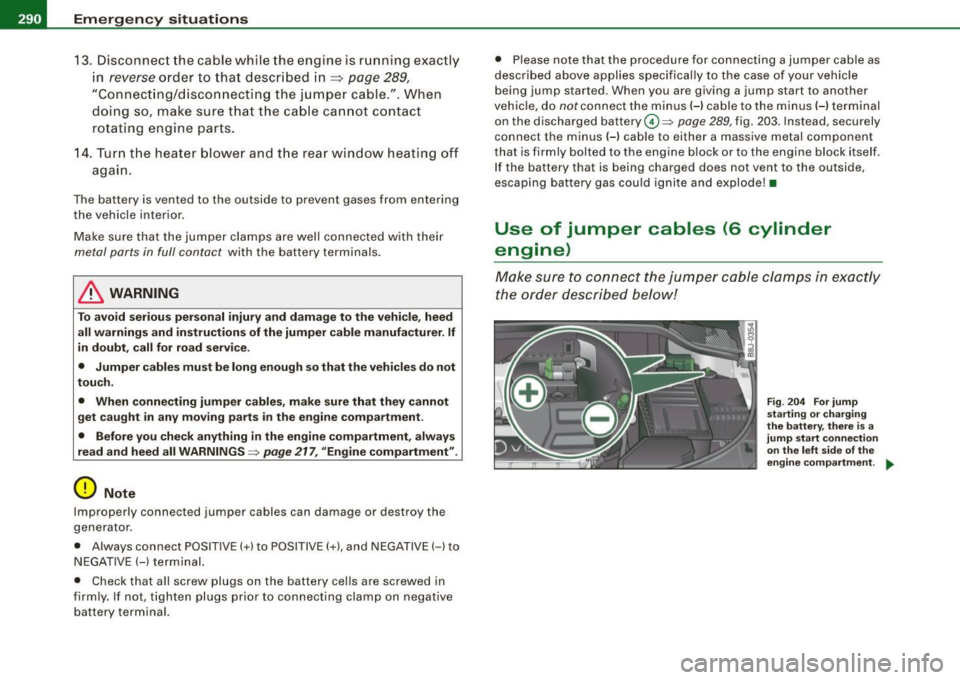
IIII.___E_ m_ e_r -=g "-e_ n _ c-=y _ s_ i_t _u _a _t_ i_o _n_ s _______________________________________________ _
13. Disconnect the c able while the engine is r unning exactly
in
reverse order to that described in~ page 289,
"Connecting/d isconnecting the jumper ca ble .". When
doing so, make sure t hat the cable cannot contact
rotating engine parts.
14 . Tur n the heater blower and t he rea r window heating off
again .
The battery is vented to the outside to prevent gases from entering
the vehicle interior.
Make sure that the jumper clamps are well connected with their
metal par ts in full contac t with the battery terminals.
& WARNING
To avoid seri ous pe rson al injur y and d am age to the vehi cle , heed
all warning s and in struct ion s of the jumper cable m anufa ctur er. If
in doubt , call for ro ad se rvic e.
• Jumper cable s mu st be l ong enough so that the vehicle s do not
t ou ch .
• When connecting jumper cable s, make sure that th ey cannot
g et ca ught in any mov ing p arts in the e ngine compa rt m ent .
• Bef ore you che ck anything in the engine com partment , al way s
r ea d and h eed all WARNINGS ~
page 217, "Engine compar tment".
0 Note
Improperly connected jumper cables can damage or destroy the
generator.
• Always conn ect POSITIVE ( +l to POSITIVE( +), and NEGATIVE( -) to
NEGAT IVE( -) terminal.
• Check that all screw plugs on the battery cel ls are screwed in
firm ly. If no t, tigh ten plugs prior to connecting clamp on negative
battery term inal. •
Please no te that the procedure for connecting a jumper cable as
described above applies specifical ly to the case of your vehicle
being jump started. When you are giving a jump start to another
veh ic le , do
not connect the minus(-) cab le to the minus( -) terminal
on the discharged battery ©~
page 289 , fig. 203 . Instead, securely
connect the minus( -) cab le to either a massive metal component
that is firmly bolted to the engine block or to the engine block itself .
I f the battery that is being charged does not vent to the outside,
escap ing battery gas cou ld ignite and explode !•
Use of jumper cables (6 cylinder
engine)
Make sure to connect the jumper cable clamps in exactly
the order described below!
Fi g. 2 04 For jump
starti ng or charging
th e batt ery, th ere is a
j ump start co nnect io n
o n th e le ft side o f the
en gine com partment. .,_
Page 294 of 324
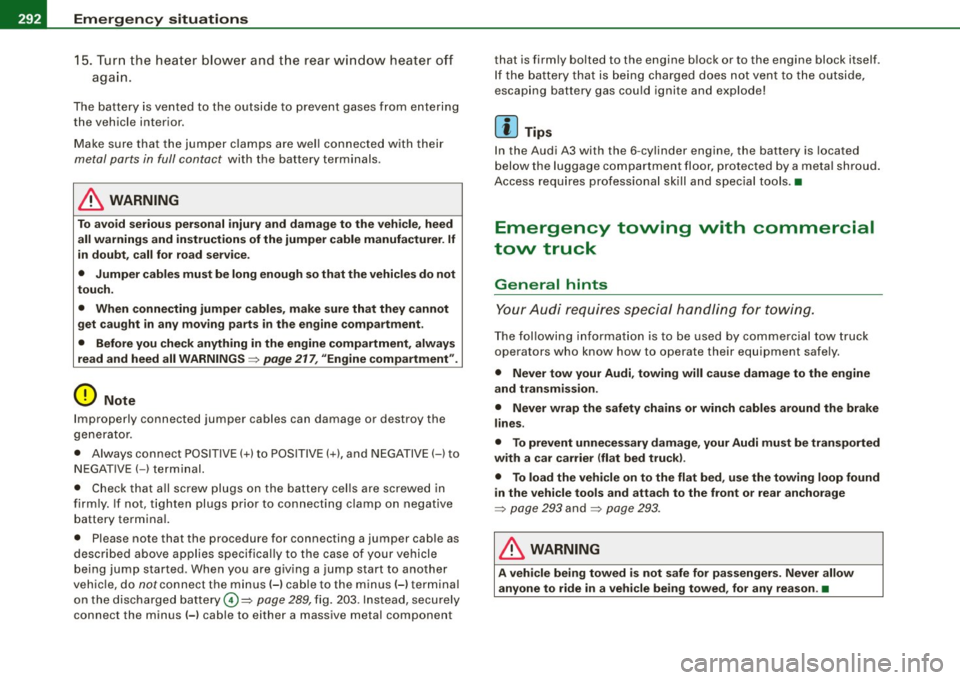
-L~E=m~e::,r~g~e~n~c::.y!'....:s~i:,.::t~u=.,::a:=.:t:!i.:::o:.:.n.:.:s~ ---------------------------------------------
15. Turn the hea ter blowe r and th e rear wind ow heat er off
aga in.
The battery is ve nted to the outs ide to preve nt gases from e nter ing
the veh icle interior.
M ake sure tha t th e jum per c lamps are well co nnected w ith their
metal parts in full contact with the battery terminals .
& WARNING
To avoid serious personal injury and damage to the vehicle , heed
all warnings and instructions of the jumper cable manufacturer. If
in doubt , call for road service .
• Jumper cables must be long enough so that the vehicles do not
tou ch .
• When connecting jumper cables , make sure that they cannot
get caught in any moving parts in the engine compa rtment .
• Before you check anything in the engine compartment , always
read and heed all WARNINGS=>
page 217, "Engine compartment ".
0 Note
Improperly connected jumper cab les can damage or destroy the
ge nerator.
• Always connec t POSI TIVE (+) to P OSITIV E(+), and NEGATIVE (-l to
N EGA TIVE( -) te rmi nal.
• Chec k th at a ll screw plugs o n the ba ttery cel ls are screwe d in
fi rm ly. If not, t ighten plu gs prio r to connect ing cla mp on neg ative
batte ry te rmina l.
• Please note that the procedure for connecting a jumper cab le as
de scribed abo ve applies specifical ly to the case of y our vehicle
being ju mp s tarted. W hen you ar e giving a jump start to anoth er
vehic le, do
not connect the mi nus( -) ca ble to the m inus( -) te rmina l
on the disc ha rged battery ©=>
page 28 9, fi g. 203. Ins tead, secu re ly
connect the minus( -) cable to either a massive metal component that is firm
ly bolted to the engine b lock or to the engine block itself.
I f t he b att ery t hat is bei ng c harge d does not vent t o th e ou ts id e,
escap ing battery gas cou ld ignite and explode !
[ i ] Tips
In the Aud i A3 with the 6 -cy linder engine, the battery is located
b el ow the luggage c ompartmen t fl oor, pro tec ted by a me ta l sh rou d.
Access requ ires pro fess io na l skill and special tools. •
Emergency towing with commercial
tow truck
General hints
You r Audi req uir es s pec ial ha ndl ing fo r t owin g.
T he fo llo wi ng infor matio n is to b e used by com merc ial tow t ru ck
operators who know how to operate the ir equ ipment safe ly.
• Never tow your Audi , towing will cause damage to the engine
and transmission .
• Never wrap the safety chains or winch cables around the brake
lines .
• To prevent unnecessary damage, your Audi must be transported
with a car carrier (flat bed truck) .
• To load the vehicle on to the flat bed , use the towing loop found
in the vehicle tools and attach to the front or rear anchorage
=> p ag e 293 and => page 293.
& WARNING
A vehicle being towed is not safe for passengers. Never allow
anyone to ride in a vehicle being towed , for any reason . •
Page 297 of 324
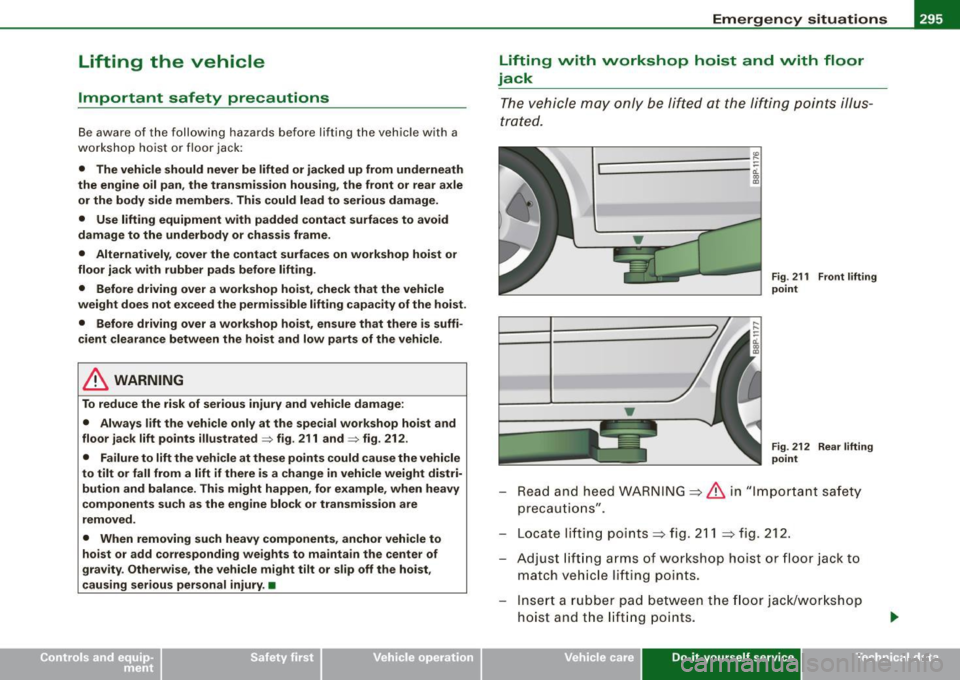
________________________________________________ E_ m_ e_r .::g :...e_ n _ c_,y'-- s_ i_t _u _a_ t_ i_o _n_ s _---JIIII
Lifting the vehicle
Important safety precautions
Be aware of the following hazards before lifting the vehicle with a
workshop hoist or floor jack:
• The vehicle should never be lifted or jacked up from underneath
the engine oil pan, the transmission housing, the front or rear axle
or the body side members. This could lead to serious damage.
• Use lifting equipment with padded contact surfaces to avoid
damage to the underbody or chassis frame.
• Alternatively, cover the contact surfaces on workshop hoist or
floor jack with rubber pads before lifting .
• Before driving over a workshop hoist, check that the vehicle
weight does not exceed the permissible lifting capacity of the hoist .
• Before driving over a workshop hoist, ensure that there is suffi
cient clearance between the hoist and low parts of the vehicle .
& WARNING
To reduce the risk of serious injury and vehicle damage:
• Always lift the vehicle only at the special workshop hoist and
floor jack lift points illustrated=> fig. 211 and=> fig. 212 .
• Failure to lift the vehicle at these points could cause the vehicle
to tilt or fall from a lift if there is a change in vehicle weight distri
bution and balance. This might happen, for example, when heavy
components such as the engine block or transmission are
removed .
• When removing such heavy components, anchor vehicle to
hoist or add corresponding weights to maintain the center of
gravity . Otherwise , the vehicle might tilt or slip off the hoist,
causing serious personal injury. •
Lifting with workshop hoist and with floor
jack
The vehicle may only be lifted at the lifting points illus
trated.
.... L===========::::==:: ~ 0:.
Fig . 211 Front lifting
point
Fig . 212 Rear lifting
point
Read and heed WARNING~ & in "Important safety
precautions ".
Locate lifting points~ fig. 211
~ fig. 212.
Adjust lift ing arms of workshop hoist or floor jack to
match vehicle lifting points.
Inse rt a rubber pad between the floor jack/workshop
hoist and the lifting points.
Vehicle care Do-it-yourself service irechnical data
Page 298 of 324
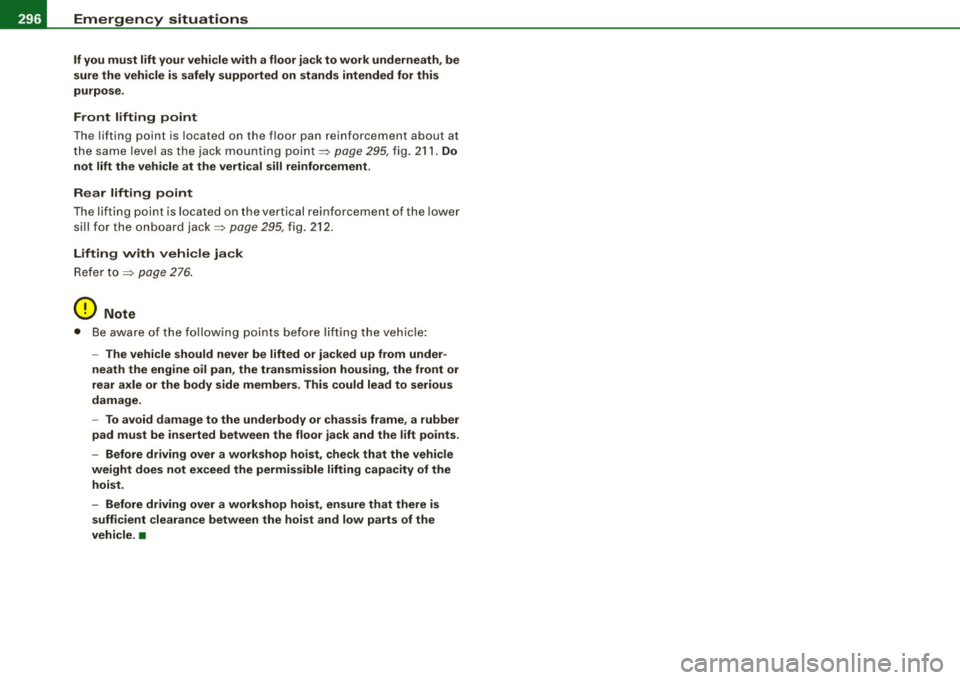
11111.___E_ m _ e _r-==g :...e_ n_ c...:y _ s_ i_t _u _a _t_ i_o _n_ s _______________________________________________ _
If you mu st lift your veh icle with a floor jack to work underneath , be
sure the vehicle is safely supported on stands intended for this
purpose .
Front lifting point
T he lifting point is located on the floor pan reinforcement about at
t he same leve l as t he jac k mou nti ng poi nt=>
pag e 295, fig. 2 11. Do
not lift the vehicle at the vertical sill reinforcement .
Rear lifting point
T he lifting point is located on the vertical reinforcement of the lower
sill for the o n board jack=>
page 295, fi g. 212 .
Lifting with vehicle jack
Refe r to=> page 276.
0 Note
• Be aware of the fo llo wi ng po ints before l ifting t he ve hicle :
- The vehicle should never be lifted or jacked up from under
neath the engine oil pan , the transmission housing , the front or
rear axle or the body side members . This could lead to serious
damage.
- To avoid damage to the underbody or chassis frame , a rubber
pad must be inserted between the floor jack and the lift points .
- Before driving over a workshop hoist, check that the vehi cle
weight does not exceed the permissible lifting capacity of the
hoist .
- Before driving over a workshop hoist , ensure that there is
sufficient clearance between the hoist and low parts of the
vehicle. •
Page 306 of 324
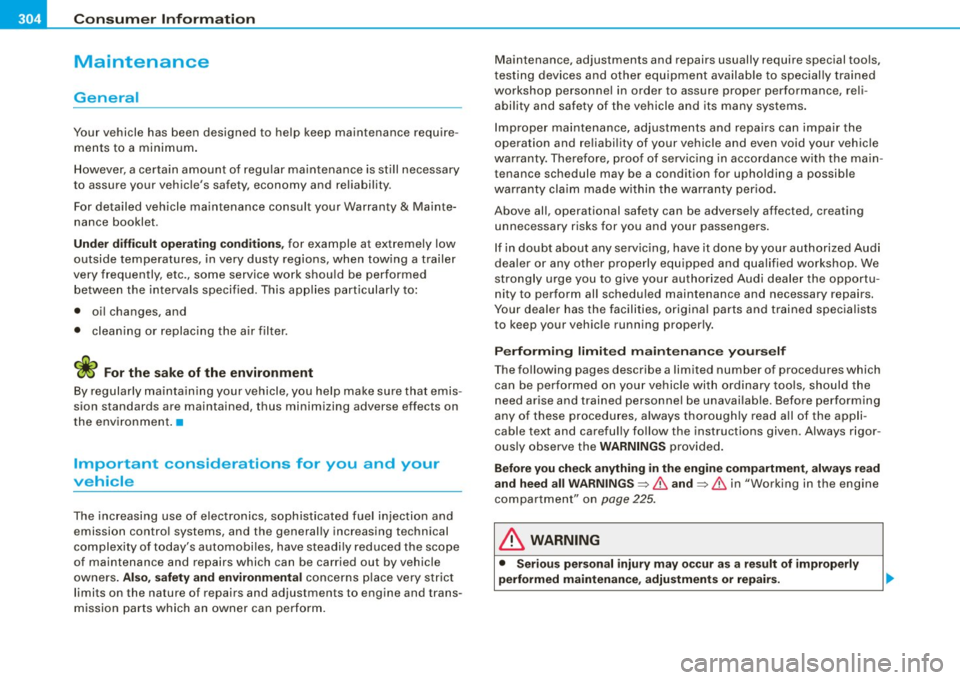
__ _.:C~ o'...'..n~ s~ u'..'..m ~ e~ r~ ln'....'...'.. f.::: o '...'..r ~m ~ a:_: t:.:. i.:::o '...'..n..:__ _____________________________________________ _
Maintenance
General
Your vehicle has been designed to help ke ep maintenance require
ments to a mi nim um .
Ho weve r, a certain a mount of regu lar maintenance is still necessary
to assure your vehicle's safety, economy and reliability.
For detailed vehicle maintenance consult your Warranty
& Main te
nance booklet.
Under d iffi cult op erating cond ition s, for example at extremely low
outside temperatures, in very dusty regions, when tow ing a trailer
very frequently, etc., some service work shou ld be performed
between the intervals specified. This app lies particularly to :
• oil changes, and
• clean ing or replac ing the air filter .
sion standards are maintained, thus minimizing adverse effects on
the environment .•
Important considerations for you and your
vehicle
The increasing use of electronics, sophisticated fuel injection and emission control systems, and the general ly increasing technical
complexity of today's automobi les, have steadily reduced the scope
of maintenance and repairs which can be carried out by vehicle
owners .
Also , safety and environm ental concerns p lace very s trict
limits on the nature of repairs and adjustments to engine and trans
mission parts which an owner can perform . Maintenance, adjustments and repairs usually require special tools,
t esting devices and other equipment availab le to special ly trained
workshop personne l in order to assure proper performance, reli
abi lity and safety of the vehicle and its many systems .
I mproper maintenance, adjustments and repa irs can impa ir the
operation and re liability of your vehicle and even void your vehic le
wa rranty. Therefore, proof of se rvic ing in accordance w ith the ma in
tenance schedule may be a condition for upholding a possible
war ranty claim made within the warranty period.
Above all, operational safety can be adverse ly affected, creating
unnecessary risks for you and your passengers .
I f in doubt about any servicing, have it done by your authori zed Audi
dea ler or any other properly equipped and qualified workshop . We
strongly urge you to give your authorized Audi dealer the opportu
nity to perform all schedu led maintenance and necessary repairs.
Your dealer has the facilities, origina l parts and trained special ists
to keep your vehicle running proper ly.
Performing limited ma intenan ce your self
The following pages describe a limited number of procedures which
can be performed on you r vehicle wi th ordinary too ls, should the
need arise and trained personnel be unavailab le . Before performing
any of the se procedu res, a lways thorough ly read a ll of the appli
cable text and carefu lly fo llow the instructions given . Always rigor
ous ly observe the
WARNINGS provided .
Before you check anything in the engine compartment , alway s re ad
and heed all WARNINGS=>
& and=> & in "Wo rking in the engine
compartment" on
page 225.
& WARNING
• Seriou s per son al injury may oc cur as a result of improperly
performed maintenan ce, adjustment s or repairs .
Page 307 of 324
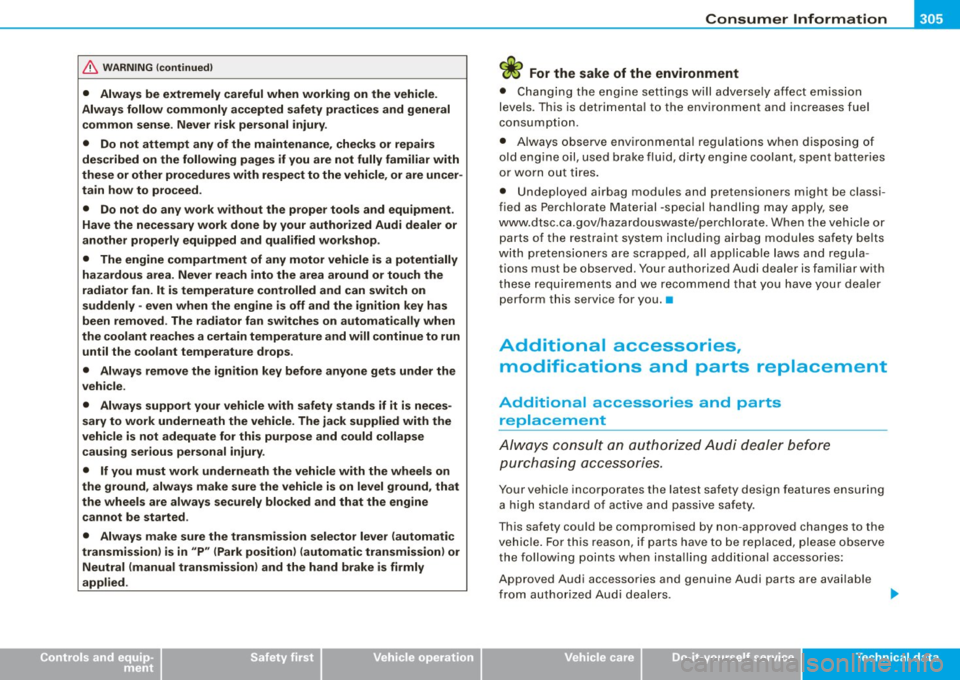
------------------------------------------------=C :..:o=. n :..:..: s:..:u::.: m:...:..:. e::.:.. r..:l~ n .:..:f:..: o:.: r :..:m~ a::.:. ti:.:o::. n:....:__ _11111
& WA RNIN G (continu ed )
• Alway s be extremely careful when working on the v ehicle .
Alway s follo w commonly accepted safety pr actice s and general
c ommon sen se . Never risk per sonal inju ry .
• Do n ot attempt any of the m aint enance , check s or rep air s
de scribed on the following pages if you are not fully famili ar with
the se or othe r procedures with respect to the vehicle , or are u ncer
t a in ho w to pro ceed .
• Do not do any work w ithout the proper tool s and equipment .
Have the necessary work done by your authorized Audi de aler or
anothe r properly equipped and qual ified work shop .
• The engine compartment of any motor vehicle i s a potentially
h azardou s are a. Ne ver rea ch into the are a around or touch the
radiator fan. It is te mperature controlled and can switch on
s uddenly · even when the engine is off and the ignition key has
been remo ved . The radi ator fan switches on automat icall y when
the coolant reaches a certain temperature and will continue to run
until the coolant t emper ature drops .
• Alway s remo ve the ignition key befor e anyone get s under the
v ehi cle .
• Alway s support your vehicle with safety sta nd s if it i s nece s
sary to work underneath the vehicle . The ja ck supplied with the
vehi cle is not adequate for this p urpo se a nd co uld coll apse
c au sing ser iou s person al in jur y.
• If you m ust w ork under neath the vehi cle with the wheel s on
the ground , alway s make sure the vehicle is on lev el ground , that
the wheels are alway s secu rel y blocked and that the engine
c annot be started .
• Alway s make sure the t ran sm iss ion selector lever (automat ic
tran smi ssion ) is in "P " (Park position ) (automati c transmis sion) or
Neutr al ( ma nual transmission ) and the h and brake i s firmly
appli ed .
Controls and equip ment Safety first Vehicle operation
<£' For the sake of the environment
•
Changing the engine settings will adverse ly affect em ission
levels. This is detrimental to the environment and increases fuel
consu mption.
• Always observe environmenta l regulations when disposing of
old engine oil, used brake fluid, d irty engine coolant, spent batteries
or worn out tires .
• Undeployed airbag modules and pretensioners might be classi
fied as Perch lorate Material -special handling may apply, see
www.dtsc.ca.gov/hazardouswaste/perchlo rate. When the vehicle or
parts of the restraint system including airbag modules safety be lts
with pretensioners are scrapped, a ll applicable laws and regu la
tions must be observed. Your authorized Audi dealer is familiar with
these requirements and we recommend that you have your dea ler
perform this service for you. •
Additional accessories,
modifications and parts replacement
Additional accessories and parts
replacement
Al ways consult an authorized Au di de aler befo re
purchasing accessories.
Your vehicle incorporates the latest safety design features ensuring
a high standard of act ive and passive sa fety.
This safety could be compromised by non -approved changes to the
vehic le . Fo r th is reason, if par ts have t o be re p laced, please observe
the fo llowing points when insta lling additional accessories:
Approved Audi accessories and genuine Audi parts are available
from autho rized Audi dealers . .,_
Vehicle care Do-it-yourself service Tec hn ica l da ta
Page 308 of 324

___ C_ o_n_ s_ u_m _ e_ r_ ln_ f_ o _r _m _ a_ t_ i_o _n ______________________________________________ _
These dealers also have the necessary facilities, tools and trained
specialists to install the parts and accessories properly.
& WARNING
Using the wrong spare parts non-approved accessories can cause
serious personal injury.
• Use only accessories expressly approved by Audi and genuine
Audi spare parts
• These parts and accessories have been specially designed to
be used on your vehicle.
• Never install accessories such as telephone cradles or
beverage holders on airbag covers or within the airbag deploy
ment zones. Doing so will increase the risk of injury if airbags are
triggered in an accident!
• Before you check anything in the engine compartment, always
read and heed all WARNINGS=>
page 217.
0 Note
• If items other than genuine Audi spare parts, add -on equipment
and accessory items are used or if repair work is not performed
according to specified methods, this can result in severe damage to
your vehicle's engine and body (such as corrosion) and adversely affect your vehicle's warranty.
• If emergency repairs must be performed elsewhere, have the
vehicle examined by an authorized Audi dealership as soon as
possible.
• The manufacturer cannot be held liable for damage which occurs
due to failure to comply with these stipulations .•
Installing/replacing a sound system
If you wish to install a radio or replace the factory installed radio,
please note the following: The
factory installed radio connectors are designed for genuine
Audi radios. When installing a different radio, difficulties could arise
such as :
- the radio may not fit into the space provided
- the electrical connections may not be compatible
- different connector terminals may be needed .
Therefore, we recommend that you have your authorized Audi
dealer install or replace the radio .
They are the most familiar with the technical features of your
vehicle. They also offer Genuine Audi Radios with the necessary
installation components and instructions.
& WARNING
Improperly installing a radio could cause a short circuit and an
electrical fire. •
Technical Modifications
Our guidelines must be complied with when technical
modifications are made.
Always consult an authorized Audi dealer before starting work on
any modifications.
This will help ensure that vehicle function, performance and safety
are not impaired=> &.
Attempting to work on electronic components and the software
used with them can cause malfunctions. Because of the way elec
tronic components are interconnected with each other, such
malfunctions can also have an adverse affect on other systems that
are not directly involved. This means that you risk both a substantial
reduction in the operational safety of your vehicle and an increased
wear of vehicle parts => & . .,_
Page 311 of 324
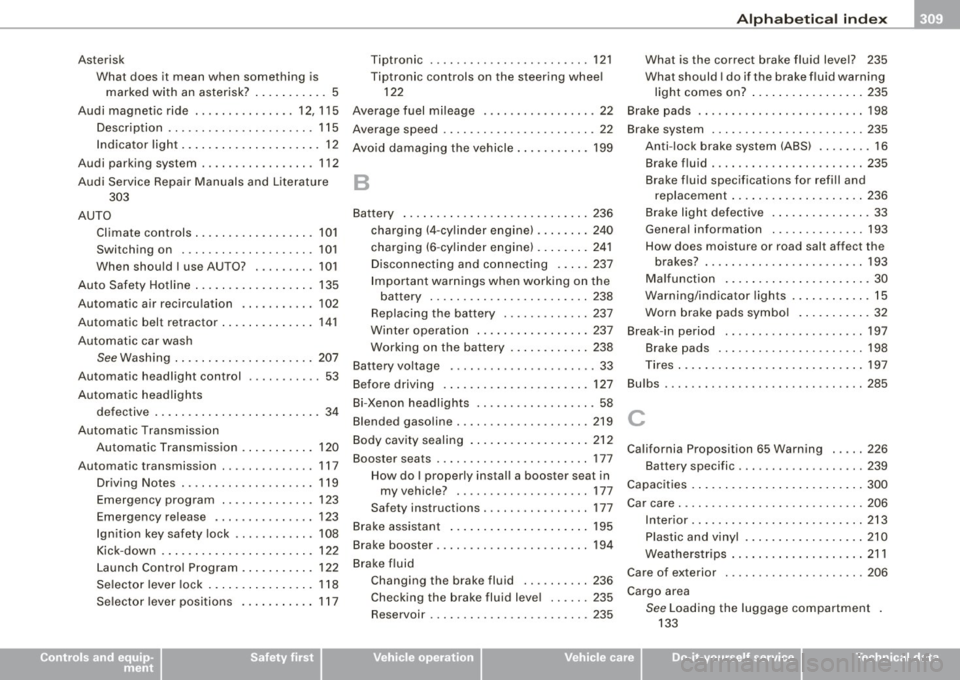
______________________________________________ A_ l_,_ p _h_ a_ b_e _t_i c_ a _ l _in _ d_e _ x __ lll
Asterisk
What does it mean when something is marked with an asterisk? ... .. .. .. .. 5
Audi magnet ic ride .. .... .... ..... 12, 115
Description ...................... 115
Ind icator light .. ...... .... .... .... . 12
Audi parking system ................. 112
Audi Service Repair Manuals and Literature 303
AUTO Climate controls ...... .... ... .... . 101
Switching on .................... 101
When should I use AU TO? . ....... . 10 1
Au to Safety Ho tline ... .. .... .... .... . 135
Automatic air recircu lation ........... 102
A utomatic belt retracto r ...... .... .... 1 41
Automa tic car wash
See Washing ...... .... ... .. .. .... 207
Automatic headlight control ....... .... 53
Automat ic headlights
defective ... .. .... .... ... .... .... . 34
Automat ic Transmission
Au tomatic Transmission . ...... .... 120
Automatic transmission . ............. 117
Driving Notes . . . . . . . . . . . . . . . . . . . . 119
Emergency program . ........... .. 123
Emergency release . . . . . . . . . . . . . . . 123
I gn ition key safety lock ....... .... . 108
Kick-down ... .... .... .... ... .... . 122
L aunch Co ntrol Program ...... ..... 122
Se lector lever lock .. ...... ...... .. 1 18
Se lecto r lever posi tions .. ...... ... 11 7
Controls and equip
ment Safety first
T
iptronic ... .... . .. .. ... ... .. .... 121
Tiptronic controls on the steering whee l
122
Average fuel mileage ................ . 22
Average speed ... .... ..... ... .... ... . 22
Avo id damagi ng the v ehicle ...... .... . 199
B
Battery ... .. .... ... .... .... .... .... 236
charg ing (4-cy lind er engine) . ....... 240
c harging (6 -cy li n der engine) ... ..... 241
Disconnecting and c onnecting .. ... 237
I mpo rtant warnings when working on the
battery . .... .... .... .... .... ... 238
Replaci ng the battery .. ... .... .... 237
Winter operation ... .. .... .... .... 237
Working on the battery .. ...... .... 238
Battery voltage ...................... 33
Before driving . ....... .. .... .... .... 127
Bi -Xenon headlights .. ........ .... ... . 58
Blended gasoline . ... ... ..... .... .... 219
Body cavity sealing ...... ...... ... .. . 212
Booster seats .... .... .... .... .... ... 177
How do I properly install a booster seat i n
my vehicle? .. ... .... .... .... ... 177
Safety instructions ................ 177
Brake assistan t ..... .... .... .... .... 195
Brake booster .......... ...... ..... .. 194
Brake fluid Changing the brake fluid .. ........ 236
Checking the brake fluid leve l .. .... 235
Reservoir ........................ 235 What is
the correct brake fluid leve l? 235
What should I do if the brake fluid warning
light c omes on? ... .. .... .... .... 235
Brake pads ... ... .... ....... .... ... . 198
Brake system ....................... 235
Anti -lock brake system (ABS) .. .... .. 16
Brake fluid ....................... 235
Brake f luid specifications for refi ll and
r eplacement ... .. .... .... ...... . 236
Brake light defective . ........ .... .. 33
General information .. .... .... .... 193
How does moisture or road salt affect the
b rakes? .. ............... .... ... 193
Ma lfunct io n . .... .... .... .... ..... 30
Warning/indica tor lights .... .... .... 15
Worn brake pads symbo l ...... .... . 32
Break -in period ...... .... .... .... ... 197
Brake pads ....... ........ ....... 198
Tires ... .. .... .... .... ... .... .... 197
Bu lbs .... .... .... .... ... ....... .... 285
C
California Proposition 65 Warning . .... 226
Battery specific ...... ... .. ... ..... 239
Capac it ies . .... ... ... .... ... .... .... 300
Car care . .... ........ ....... .... .... 206
In ter ior . ...... .... .... ... .... .... 213
P last ic a nd vinyl . ...... .... .... ... 210
Weatherstrips ... .. .... ...... ... .. 211
Care of exterior .... ... .. .... .... .... 206
Ca rgo area
See Loading the luggage compartment
133
Vehicle operation Vehicle care Do-it-yourself service Technical data
Page 312 of 324
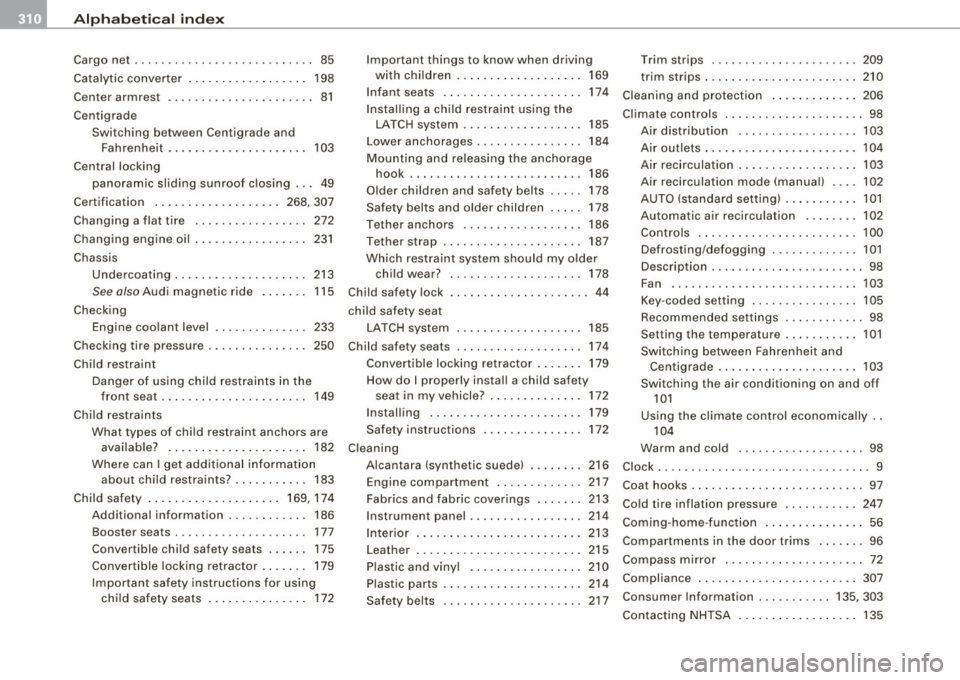
___ A_l.:,. p _h_ a_ b_e _t _ic _ a_l _in _ d_e _x ____________________________________________ _
Cargo net .... .... ...... .. ... ..... ... 85
Catalytic converter . . . . . . . . . . . . . . . . . . 198
Center armrest . . . . . . . . . . . . . . . . . . . . . . 81
Centigrade Switching between Centigrade and Fahrenheit ..................... 103
Central locking panoramic sliding sunroof closing .. . 49
Certification . . . . . . . . . . . . . . . . . . . 268, 307
Changing a flat tire ...... .... ....... 272
Changing engine oi l .. .... .... .... ... 231
Chassis Undercoating . . . . . . . . . . . . . . . . . . . . 213
See also Audi magnetic ride
Checking 115
Engine coolant level .. .... .... .... 233
Checking tire pressure ...... ........ . 250
Child restraint
Danger of using child restraints in the
front seat . . . . . . . . . . . . . . . . . . . . . . 149
Child restraints What types of child restraint anchors are available? ... .... .... ......... . 182
Where can I get additional information
about child restraints? ... .... .... 183
Child safety ...... ... .... .... ... 169, 174
Additional information .... .... .... 186
Booster seats . . . . . . . . . . . . . . . . . . . . 177
Convertible child safety seats . . . . . . 175
Convertible locking retractor . . . . . . . 179
Important safety instructions for using child safety seats .. ......... .... 172 Important things to know when driving
with children ................... 169
Infant seats ..................... 174
Installing a child restraint using the
LATCH system . . . . . . . . . . . . . . . . . . 185
Lower anchorages . . . . . . . . . . . . . . . . 184
Mounting and releasing the anchorage
hook .... .... ... ........ .... ... 186
Older children and safety belts . .... 178
Safety belts and ol dler children .... . 178
Tether anchors .... .... .... ... ... 186
Tether strap .... ... .... .... .... .. 187
Which restraint system should my o lder
child wear? .. .... .... .... ...... 178
Child safety lock ..................... 44
child safety seat LATCH system . .... .... .... .... .. 185
Child safety seats ... ........... ..... 174
Convertible locking retractor . ...... 179
How do I properly install a child safety
seat in my vehicle? .. ...... .... .. 172
Installing .... ...... ... .... .... .. 179
Safety instructions . . . . . . . . . . . . . . . 172
Cleaning Alcantara (synthetic suede) . .... ... 216
Engine compartment ... .... ...... 217
Fabrics and fabric coverings ..... .. 213
Instrument panel .. ... .. .... .... .. 214
Interior .. .... .... ..... .... .... .. 213
Leather .. .... ... .......... ...... 215
Plastic and vinyl ................. 210
Plastic parts ............... ... ... 214
Safety belts .. .... .... ... ..... ... 217 Trim
strips .... ........ .. . .. .. .. . 209
trim strips .. .... .... ... .... .... .. 210
Cleaning and protection ............. 206
Climate controls .. ........ .... .... ... 98
Air distribution .... .... ... .... ... 103
Air outlets ... .. .... .... .... ...... 104
Air recirculation ... ...... ... ...... 103
Air recirculation mode (manual) ... . 102
AUTO (standard setting) .. .... ... .. 101
Automatic air recirculation ........ 102
Controls . ........... .. .... .... .. 100
Defrosting/defogging .. ........ ... 101
Description .... ........ ....... .... 98
Fan ........ ... .. .... .... .... ... 103
Key-coded setting ..... ... . ....... 105
Recommended settings .... .... .... 98
Setting the temperature .... .... ... 101
Switching between Fahrenheit and
Centigrade ... .... .... ... .... ... 103
Switching the air conditioning on and off 101
Using the climate control economically . .
104
Warm and cold ... .... .... .... ... . 98
Clock . .... .... ............... ........ 9
Coat hooks . . . . . . . . . . . . . . . . . . . . . . . . . . 97
Co ld tire inflation pressure . ..... ... .. 247
Coming -home -function .. ...... ... ... . 56
Compartments in the door trims ... ... . 96
Compass mirror .. .... ....... .... .... 72
Compliance ........................ 307
Consumer Information .......... . 135, 303
Contacting NHTSA ... .... .... .... ... 135
Page 314 of 324
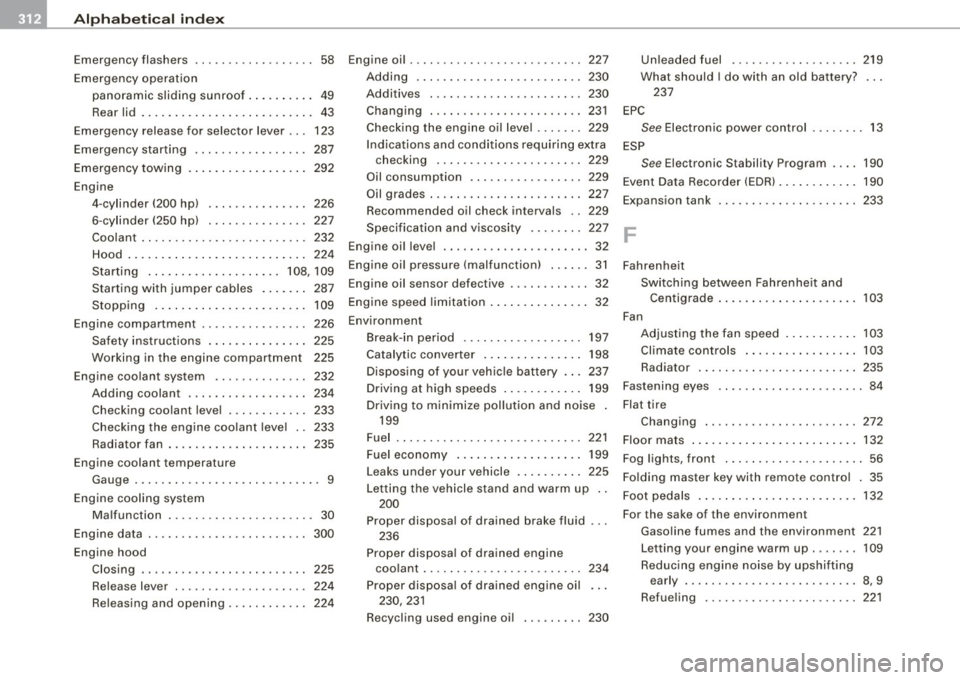
-Al
phab eti ca l ind ex
_.:_.__ ____ _...::.:...::..;.:___ ________________ _
Emergency flashers . . . . . . . . . . . . . . . . . . 58
Eme rgency operation
panoramic sliding sunroof . .... ..... 49
Rear lid . .... ... .. .... .... ...... .. 43
Emergency release for selector lever . . . 123
Emergency starting . . . . . . . . . . . . . . . . . 287
Emergency towing . . . . . . . . . . . . . . . . . . 292
Engine 4-cylinder (200 hp) ..... ... .... ... 226
6 -cylinder (250 hp) ............... 227
Coolant .......... .... ....... .... 232
Hood .... ... .. ...... .... ... .... . 224
Starting .... .... .... .... .... 108, 109
Starting with jumper cables ...... . 287
Stopping ... .... .... .... ........ 109
E . ngine compartment . .... .... .... .. .
Safety instructions ...... .... .... .
226
225
Working in the engine compar tment 225
Engine coolant system .............. 232
Adding coolant .... .... .......... 234
Checking coolant level .... .... .... 233
Checking the engine coolant leve l .. 233
Radiator fan . . . . . . . . . . . . . . . . . . . . . 235
Engine coolant temperature
Gauge .............. .............. 9
Engine cooling system
Malfunction ...... .... ....... .... . 30
E . d ngine ata ...... .... ........... .. . 300
Engine hood Closing ......................... 225
Release lever . ............... .... 224
R I . d . e easing an opening .... ... ... .. 224 Engine
oil .... ...... ........ ... .... . 227
Adding ...... ... .. .... .... ...... 230
Additives ....................... 230
Changing .. ............. ........ 231
Check ing the engine oil level .... ... 229
Indications and conditions requiring extra checking .......... ...... ...... 229
Oil consumption ................. 229
Oil grades . .... ...... ... .. .... ... 227
Recommended oil check intervals .. 229
Specification and viscosity ........ 227
Engine oil level ... ..... .. ...... ...... 32
Engine oil pressure (malfunction) ... .. . 31
Engine oil sensor defective ............ 32
Engine speed limitation .. .... .... .... . 32
Environment
B k. . d
rea -in peno .... .... .... .... . . 197
Catalytic converter . . . . . . . . . . . . . . . 198
Disposing of your vehic le battery ... 237
Driving at high speeds . . . . . . . . . . . . 199
Driving to minimize pollution and noise .
199
Fuel ............................ 221
Fuel economy . . . . . . . . . . . . . . . . . . . 199
Leaks under your vehicle . .... ..... 225
Letting the vehicle stand and warm up ..
200
Proper disposal of drained brake fluid
236
Proper disposa l of
di ra ined engine
coo lant .. .... ... .... .... .... ... 234
Proper disposa l of drained engine oil
230,231
Recycling used engine oil .. .... ... 230 Unleaded fuel
...... ... .. ... .... . 219
What should I do with an old battery?
237
EPC
See Electronic power control . . . . . . . . 13
ESP
See Electronic Stability Program .... 190
Event Data Recorder (EDR) ... .... .... . 190
Expans ion tank 233
F
Fahrenheit
Switching between Fahrenheit and Centigrade . .... .. ... ... .... .... 103
Fan Adjusting the fan speed .. .... .. .. . 103
Cl imate controls ...... ...... .... . 103
Radiator .... .... .... ... .. .... .. . 235
Fastening eyes ... ........ .... .... ... 84
Flat tire Changing ....................... 272
Floor mats . ....... ..... ... .... .... . 132
Fog lights, front ...... .... ... ... ... .. 56
Folding master key with remote control . 35
Foot pedals . ... .. .... .... ...... .... 132
For the sake of the environment
Gasoline fumes and the environment 221
Letting your engine warm up . ..... . 109
Reducing engine noise by upshifting
early ... .. .... .... ... .... .... .. 8, 9
Refueling .. ........... ........ .. 221